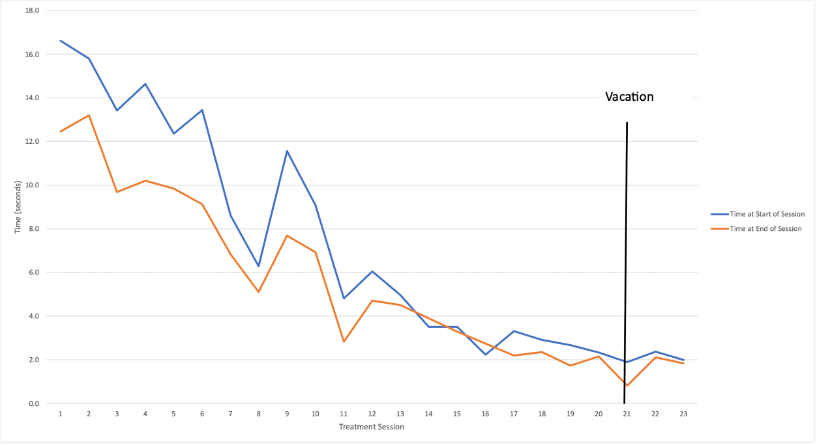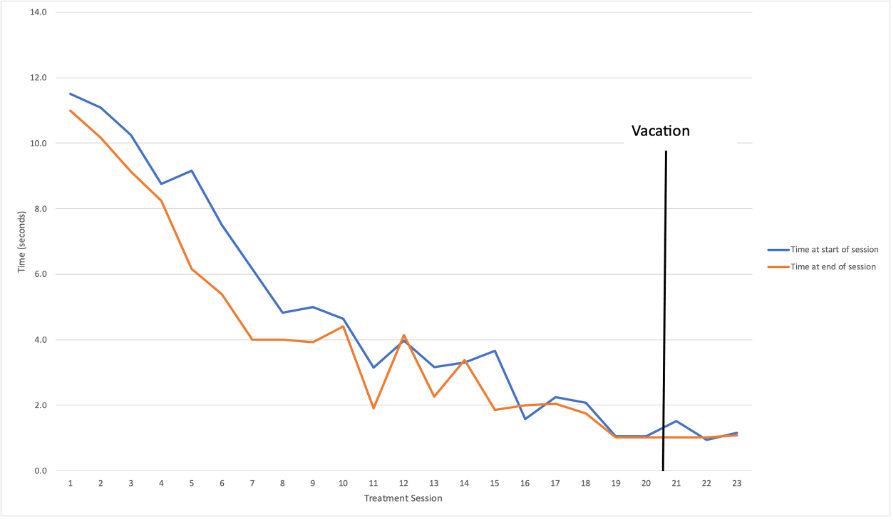The Impact of Vestibular Processing on Attention and School Performance: A case study
 The Impact of Vestibular Processing on Attention and School Performance: A case study
The Impact of Vestibular Processing on Attention and School Performance: A case study
Dominique Blanche Kiefer, OTD, OTR/L, BCP
Lisa Test, OTD, OTR/L, FAOTA
Beth White, OTR/L
Ayres’ early studies uncovered a correlation between academic performance and sensory integration/processing disorders (Ayres, 1969; 1972a). In effectiveness studies involving children with learning disorders, she emphasized the influence of sensory integration treatment on academic skills (1972b). Specifically, she highlighted the impact of vestibular hypo-responsiveness to academic performance (1978). The results of the 1978 study revealed that children with shortened post-rotary nystagmus duration demonstrated greater improvements in academic performance after sensory integration treatment compared to the control group (Ayres, 1978). When this system is under-responsive, as Ayres identified as being represented by a short duration postrotary nystagmus (PRN), individuals struggle to maintain an optimal level of arousal and ultimately have difficulty attending and staying motivated during academic activities. (Ayres, 1978; Blanche & Cermack, 2023).
This case study offers evidence supporting the link between low arousal resulting from under-responsiveness in the vestibular system and its impact on school performance. The data was collected systematically through three methods: standardized measurements at the commencement and conclusion of the 23-session intervention, measurements at the start and end of each session, and measurements taken after a one week pause in services to assess maintenance of skills.
Case Description
John is a 10-year-old boy who was born full term without complications and met all developmental milestones. He was diagnosed with Attention-Deficit/Hyperactivity Disorder, Combined Type-Moderate and was reported to have an IQ of 84. According to his psychoeducation report, his IQ is influenced by significant challenges in processing and working memory, and when these components are removed, his General Ability Index (GAI) rises into the average range.
John was referred at the end of first grade due to slumping in his chair, inability to attend, and poor handwriting, all of which impacted his academic performance. His teachers and parents expressed concerns about his limited progress during the school year and sought assistance during the summer months to prepare him for second grade. John’s teacher described him as having difficulty following directions, decreased attention, low task initiation, and requiring maximum prompting to sustain attention.
Data from the initial occupational therapy evaluation revealed that he was under responsive to vestibular and proprioceptive input, impacting his level of arousal, postural control, and feedforward motor planning. His low arousal level was also impacting executive function skills, in particular sustained attention and task completion and ultimately led to minimal learning and academic success. The data that supported John’s under responsiveness in the vestibular and low arousal level included no/low PRN, a moderate concern in the vestibular system on the Structured Observations of Sensory Integration – Motor (SOSI-M), and several clinically elevated scores on the Behavioral Rating Index of Executive Function, 2nd Edition (BRIEF-2). In addition, his teacher indicated that even with daily 1:1 instruction, he learned only approximately 25%-40% of the material and "it seems that he missed half of the school year.”
An intensive 1:1 sensory integration (SI) intervention as described by Ayres was selected to maximize gains in a short time frame. The decision to employ an intensive therapy model aligns with research demonstrating effective outcomes when intensive therapy sessions are conducted two to three times per week (Benson, 2010; Faller, 2016). John received a combination of individual therapy and academic services three times per week for 2.5 hours each between May and August 2023. In total, he attended 23 therapy sessions during a 9-week period. The sessions included OT, speech and language therapy and academic tutoring.
The SI intervention focused on increasing arousal and attention through intense vestibular and proprioceptive input. Therapeutic activities adhered to the fidelity standards outlined by Parham and colleagues (2007) and included multiple points of suspension, various swings, and a variety of equipment. The goal of the combined intervention sessions was to increase arousal level and attention to learn the material. SI theory postulates that the vestibular system impacts arousal, and by proxy, thereby affecting attention. The therapeutic activities included intense vestibular and proprioceptive input on various swings to increase arousal, and as a byproduct, attention improved as well. After 20-30 minutes of SI intervention, he transitioned to speech therapy or academic tutoring. When John’s ability to attend would wane, he returned to OT to receive sensory integration intervention targeting the vestibular and proprioceptive systems before returning to academic tutoring.
Findings
Data was collected in three different manners to evaluate the impact of sensory integrative therapy. First, an initial evaluation was conducted and included a comprehensive assessment of sensory processing, handwriting skills, and executive function abilities at home and in the school setting. Three assessments were selected as outcome measures, and Table 1 presents these selected assessments along with compiled data collected at the start and conclusion of the intensive intervention.
Table 1
Data Collection
|
Assessment |
Subtest |
Score at Evaluation |
Score at Progress Monitoring |
|
The Structured Observations of Sensory Integration – Motor (Blanche, et al., 2020) |
Overall Score |
3% |
21% |
|
Postural Control |
Moderate concern |
No concern |
|
|
Motor Planning |
Moderate concern |
No concern |
|
|
Vestibular |
Moderate concern |
Mild concern |
|
|
Proprioception |
Moderate concern |
No concern |
|
|
Fluidity |
Moderate concern |
No concern |
|
|
Assume/Copy Body positions |
No concern |
No concern |
|
|
The Comprehensive Observations of Proprioception – Revised (Blanche, et al., 2020) |
Overall |
21% |
37% |
|
Tone & Joint |
9% |
37% |
|
|
Behavioral Manifestation |
25% |
50% |
|
|
Postural Motor |
37% |
50% |
|
|
Motor Planning |
16% |
16% |
|
|
Areas of concern |
Grading of force Midrange control |
None |
|
|
Post Rotary Nystagmus Test (Ayres, 1975) |
|
Minimal, unable to be perceived in both directions |
Minimal, up to 2 seconds in both directions |
|
Behavior Rating Inventory of Executive Function, 2nd edition (BRIEF2) – Teacher (Gioia, 2015) |
Inhibit |
Potentially clinically elevated |
Not reassessed |
|
Self-Monitor |
Clinically Elevated |
||
|
Behavior Regulation Index |
Clinically Elevated |
||
|
Shift |
Clinically Elevated |
||
|
Emotional Control |
Clinically Elevated |
||
|
Emotion Regulation Index |
Clinically Elevated |
||
|
Initiate |
Clinically elevated |
||
|
Working Memory |
Clinically Elevated |
||
|
Plan/Organize |
Clinically Elevated |
||
|
Task Monitor |
Clinically Elevated |
||
|
Organization of Materials |
Potentially clinically elevated |
||
|
Cognitive Regulation Index |
Clinically Elevated |
||
|
Global Executive Composite |
Clinically elevated |
A second set of data collected measured the time required to complete a short math and reading academic test at the start and end of each session. The test comprised of answering 10 mental math problems and reading 20 words. A new set of mental math problems and 20 reading words was provided for each test. If he answered incorrectly, a prompt was provided to try again, ultimately affecting his time.
Figures 1 and 2 graph the time at the start and end of each session. The x-axis is the treatment session count; the y-axis is time in seconds to complete the task. The blue lines represent the amount of time required for him to complete the task at the start of the session; the orange line represents the amount of time required to complete the same task at the end of the session after having received sensory integration intervention or ASI®. Analyzing the data points for each session demonstrates the effectiveness of targeted interventions focused on increasing arousal levels, as evidenced by the improvement in task completion time.
The third data collection method was employed to determine maintenance of skills. Services were halted for one week, between session #20 and session #21. The line on Figures 1 and 2 indicate the pause in services and the data collected when he returned.
Figure 1
Completion time of 10 math problems at the start & end of treatment

Figure 2
Completion time of 20 reading words at the start & end of treatment

Discussion
This case study illustrates the short term and long-term effect of SI intervention for a child with vestibular under responsiveness and academic performance challenges, supporting Ayres’ (1978) study. Specifically, the data reveals the following:
- The time required for John to complete academic tasks was significantly lower after receiving Ayres sensory integration intervention aimed at increasing arousal. This short-term effect is evidenced in the measurements taken at the beginning and the end of each session.
- The time required to complete academic tasks decreased as sessions progressed indicating continual and sustained improvement over weeks and months. This long-term effect is evident in the curve over time from session #1 to session #19.
- John was able to maintain improved attention and decreased time to complete tasks after a pause in services. The vertical line symbolizes a one-week pause in services and the data demonstrates sustained improvement and maintenance of skills.
- The improvement in academic tasks correlates with improvement in sensory processing, as noted by improved outcome measures noted in Table 1.
This case study highlights the crucial role of the vestibular system in regulating arousal levels and attention, and its potential impact on school performance. Understanding the connections between vestibular processing, arousal, attention, and school performance could guide therapists in their interventions, environmental modifications, and supports/strategies to address the underlying dysfunction and enhance academic performance.
References
Ayres, A. J. (1978). Learning Disabilities and the Vestibular System. Journal of Learning Disabilities, 11(1), 30-41. https://doi.org/10.1177/002221947801100104
Ayres, A. J. (1975). Sensorimotor foundations of academic ability. Perceptual and learning disabilities in children, 2, 301-358.
Ayres A. J. (1975). Southern California Postrotary Nystagmus Test. Los Angeles: Western Psychological Services.
Ayres, A. J. (1972a). Sensory integration and learning disorders. Western Psychological Services.
Ayres A. J. (1972b). Types of sensory integrative dysfunction among disabled learners. American Journal of Occupational Therapy, 26(1), 13–18.
Ayres, A. J. (1969). Deficits in sensory integration in educationally handicapped children. Journal of Learning Disabilities, 2(3), 160-168. http://dx.doi.org/10.1177/002221946900200307
May-Benson, T. A., & Koomar, J. A. (2010). Systematic review of the research evidence examining the effectiveness of interventions using a sensory integrative approach for children. The American Journal of Occupational Therapy, 64(3), 403-414.
Blanche, E. I., & Cermak,, S. A. (2023). Hyporesponsiveness to Vestibular Input and Academic Performance. 50 Studies Every Occupational Therapist Should Know, 11(1), 193.
Faller, P., Hunt, J., van Hooydonk, E., Mailloux, Z., & Schaaf, R. (2016). Application of data-driven decision making using Ayres Sensory Integration® With a child with autism. The American Journal of Occupational Therapy, 70(1), 7001220020p1-7001220020p9.
Gioia GA, Isquith PK, Guy SC, & Kenworthy L (2015). BRIEF2: Behavior Rating Inventory of Executive Function (2nd ed.). Lutz, FL: Psychological Assessment Resources, Inc.
Parham, L. D., Cohn, E. S., Spitzer, S., Koomar, J. A., Miller, L. J., Burke, J. P., ... & Summers, C. A. (2007). Fidelity in sensory integration intervention research. The American Journal of Occupational Therapy, 61(2), 216-227.
